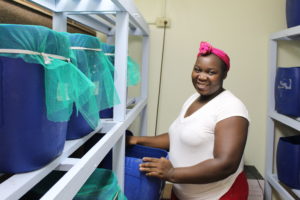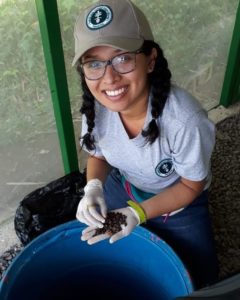Insects on the menu
Several species of hoppers, fliers and creepy crawlers are being looked at as a possible solution to food insecurity across the globe. At EARTH University, fourth years from Costa Rica, Guatemala, Ecuador and Zimbabwe have led pioneering research into the use of high-protein insects in rural food production.
The knowledge gained from these students’ graduation projects will provide communities with feasible – and environmentally sound – roadmaps by which to address the problems of malnutrition, poverty and joblessness.
Cricket, cricket
The southern African nation of Zimbabwe suffers from severe drought seasons, which trigger epidemics of malnutrition throughout its rural areas. To counter this cycle, Esnath Divasoni (’19, Zimbabwe) developed a business plan to sustainably and cheaply produce an alternative protein with year-round availability.
Her plan involves managing controlled environments for the breeding of crickets (Acheta domesticus) for human consumption. Fed concentrates and organic farm residues only twice a week, the crickets reach 62% protein after a mere six to eight weeks. At that point, they are frozen or boiled and passed through an air dryer, a solar dryer or a conventional oven. Then, they can be eaten whole or ground into a flour/protein supplement.
“Crickets are an excellent source of low-cost, low-impact protein. They require fewer resources, making it possible to take advantage of, for example, farm waste,” Esnath says.
According to the United Nations, hunger affects more than 800 million people worldwide. Armed conflicts, geographic location, economic downturns and climate change can lead to malnourishment. Wesly Curruchich (’19, Guatemala) and César Uyaguari (’19, Ecuador) have seen their communities affected by hunger. So, cricket flour became the basis of their project, too.
According to César, a single gallon of water can produce a kilo of cricket flour. “There are sustainable alternatives to resource-intensive proteins like beef,” Wesly says. “Knowing that cricket flour is one of them is very important to us. We feel we can make a positive change.”
The duo devised a chocolatey cricket-flour cookie that is high in the amino acids essential to human growth and health. Both think the biggest hurdle to growing their business will be ending the stigma of eating insects.
Soldier flies and circular economies
About 14 days into its life, the soldier fly (Hermetia illucens) achieves a high protein index – about 50 percent of its total mass.
Jennifer Torres (’19, Costa Rica) has been overseeing the production of pellets made from dried soldier flies. The project follows a circular-economy business model that ensures rural communities are in charge of producing the larvae and feeding them compost, leachate and food waste – such as banana peels, pineapple rinds and papaya skins.
The larvae are boiled, dried and ground. The resulting powder is mixed with a series of organic ingredients, producing a high-protein flour that functions as food for small livestock such as chickens, tilapia, rabbits and more.
In a few weeks, fourth-year students will conclude their year-long graduation projects – developed under the guidance of EARTH professors – and present their findings. Through the various disciplines of agricultural science, all of them have investigated interesting questions and proposed viable solutions to the problems faced by their home communities.








